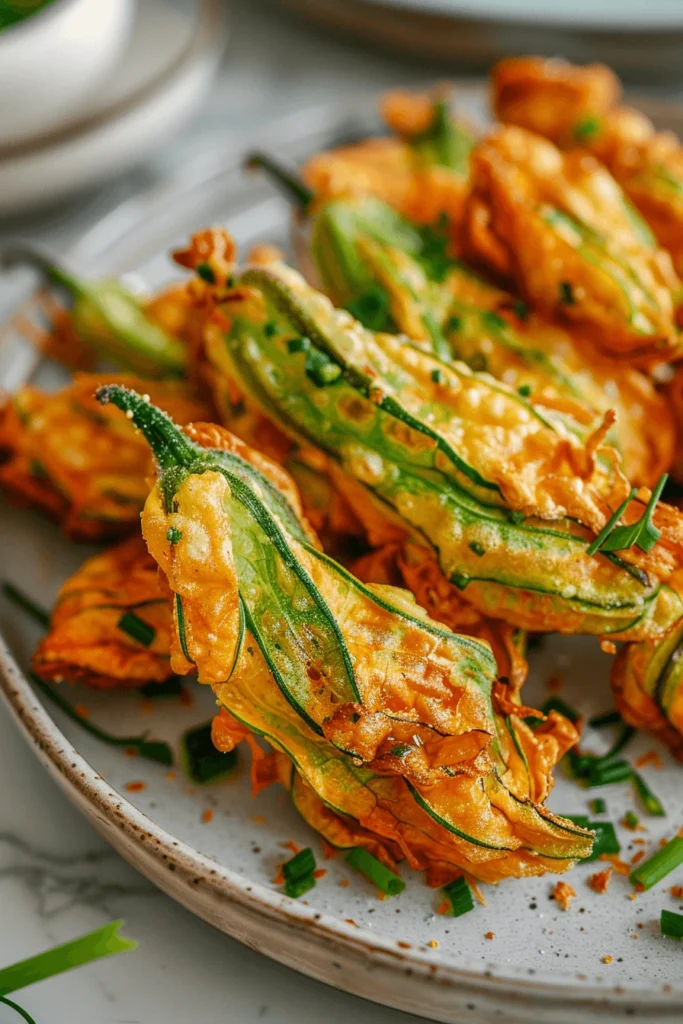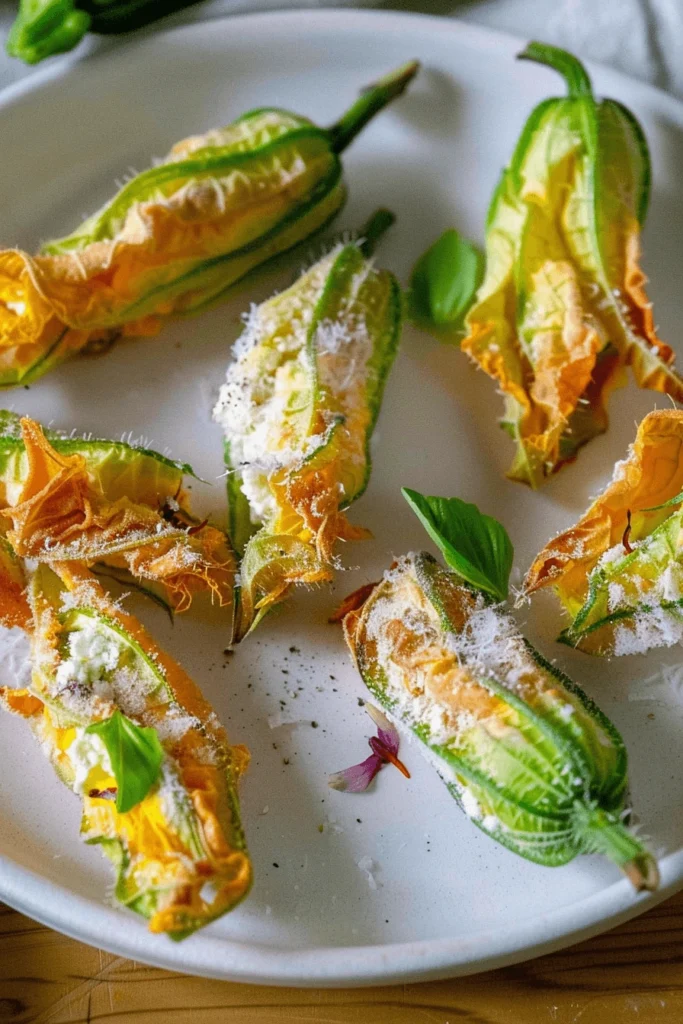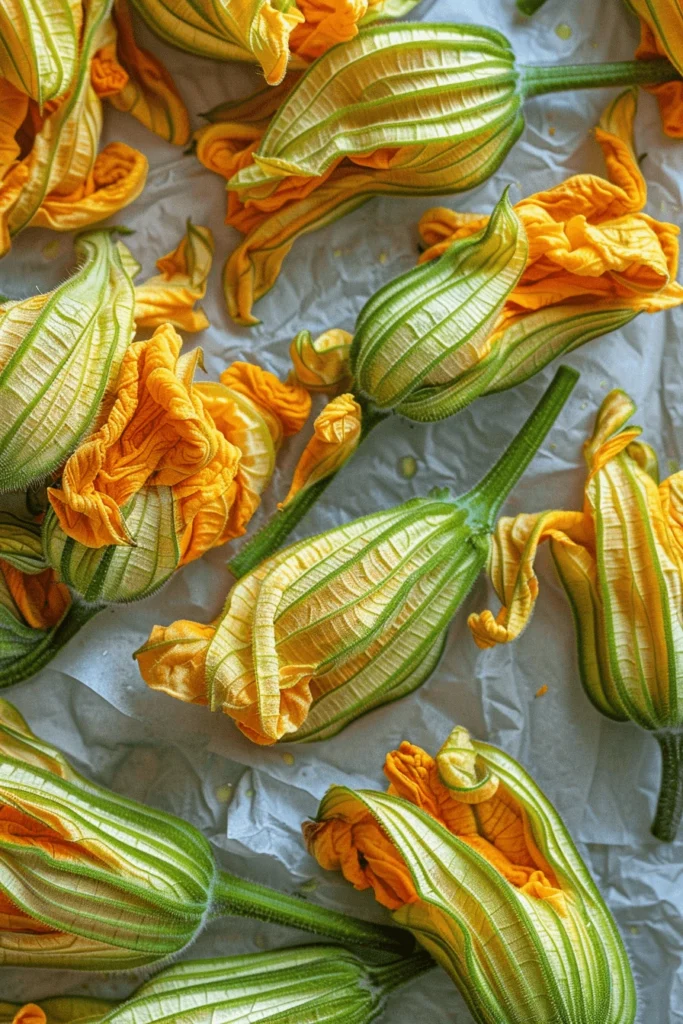Before you wrinkle your nose and say, “Wait, you mean people actually eat the flower of zucchini?” — yes, and it’s delicious. In fact, the flower of zucchini has been charming kitchens for centuries, especially in Italian and Mediterranean cooking. Think about it: while some folks are out there baking cupcakes, others are stuffing delicate blossoms with cheese, dipping them in a golden zucchini flower batter, and frying them to crunchy perfection. And let’s not forget the health kick — the flower of zucchini benefits go far beyond good taste; they’re light, packed with nutrients, and easier on the waistline than, say, a bucket of fried chicken.
In this guide, we’ll dig deep into everything you need to know about zucchini blossoms: how to identify them, the best zucchini flower recipes, when to pick them, and yes — how to cook zucchini flowers without frying (because sometimes we all need to skip the deep fryer). Whether you’re hunting for an easy zucchini flower recipe, curious about stuffed zucchini flowers, or simply want to understand how the plant works — this article has you covered.
Print
Fried Zucchini Flowers Recipe
- Total Time: 20 minutes
Ingredients
10 fresh zucchini blossoms
1 cup flour
1 cup sparkling water
½ tsp salt
Olive oil for frying
Instructions
Wash and gently dry zucchini flowers.
Mix flour, sparkling water, and salt into a light batter.
Heat oil in a skillet.
Dip blossoms into the batter and fry until golden.
Drain on paper towels and serve hot.
- Prep Time: 10 minutes
- Cook Time: 10 minutes
Nutrition
- Serving Size: 4
Table of Contents
Understanding the Flower of Zucchini
What is the Flower of Zucchini?
The flower of zucchini, also called a zucchini blossom, is one of the most underrated ingredients in the kitchen. These delicate, golden-yellow blooms grow on the zucchini plant and can be enjoyed in dozens of recipes. Unlike the zucchini itself, which is hearty and versatile, the flower of zucchini has a subtle, slightly sweet taste with a hint of squash flavor. Because of its tender texture, it can be stuffed, fried, baked, or even eaten raw in salads.
There are two types of zucchini blossoms:
- Male flowers: These grow on long, thin stems and don’t produce fruit. They’re the ones most often used in cooking since harvesting them doesn’t reduce the zucchini harvest.
- Female flowers: These have a small baby zucchini at the base. While edible, they’re usually left on the plant so the zucchini can grow to full size.
In other words, when you’re enjoying a fried zucchini flower or a light zucchini blossom recipe, you’re most likely savoring the male flower.
The Cultural and Culinary Significance of Zucchini Blossoms
The zucchini flower recipe isn’t a new invention—it’s been a staple in Mediterranean kitchens for centuries. In Italy, stuffed zucchini flowers are a beloved summertime dish, often filled with creamy ricotta cheese, dipped in a light zucchini flower batter, and fried until crispy. In Mexico, zucchini blossoms (known as flor de calabaza) appear in quesadillas, soups, and tamales.
These blossoms are considered a delicacy not because they’re rare, but because they’re fragile. Once picked, they wilt quickly, which is why you won’t often see them piled high in grocery stores. Instead, they’re usually sold at farmers’ markets or harvested fresh from backyard gardens.
So why all the fuss? Because once you taste a perfectly cooked fried zucchini blossom or a delicate easy zucchini flower recipe, you’ll understand why chefs and home cooks rave about them. They bring a light, floral note to dishes that zucchini alone just can’t deliver.
Nutritional Value and Flower of Zucchini Benefits
Nutrient Breakdown
The flower of zucchini might look delicate, but don’t let its fragile petals fool you — these blossoms are surprisingly nutrient-packed. Each serving is low in calories yet offers essential vitamins and minerals that your body craves. On average, a 100-gram serving of zucchini blossoms contains only about 15–20 calories, making them a smart choice for anyone looking to add flavor without the guilt.
Here’s a quick snapshot of what zucchini blossoms bring to the table:
| Nutrient | Benefits |
|---|---|
| Vitamin A | Supports healthy skin, vision, and immunity |
| Vitamin C | Boosts the immune system and helps with collagen production |
| Calcium | Strengthens bones and teeth |
| Iron | Supports energy levels and healthy blood circulation |
| Fiber | Improves digestion and keeps you feeling full |
Unlike heavy, calorie-dense foods, zucchini blossoms give you nutrition without weighing you down. This makes them ideal for summer meals or lighter dining options.
Why Include Zucchini Blossoms in Your Diet?
Adding the flower of zucchini to your recipes isn’t just about taste; it’s about health, too. Let’s break down the main flower of zucchini benefits:
- Weight-Friendly Ingredient
With their low-calorie count and high nutrient profile, zucchini flowers are perfect for anyone trying to keep meals light while still satisfying. - Digestive Health
Their fiber content helps keep digestion smooth. Unlike fried fast food, a plate of lightly sautéed zucchini blossoms won’t leave you feeling sluggish. - Immune Support
Packed with vitamins A and C, these blossoms help protect against seasonal colds and keep your skin glowing. - Versatile in Recipes
From a zucchini blossom recipe stuffed with ricotta to a salad sprinkled with raw petals, they can be enjoyed in countless forms. - Gluten-Free and Vegan Friendly
If you’re cooking for guests with dietary restrictions, zucchini blossoms are a safe, flavorful choice.
In short, the flower of zucchini benefits both your health and your taste buds. Whether you’re enjoying fried zucchini flowers, a light soup, or an easy zucchini flower recipe, you’re fueling your body with nutrients while indulging in a culinary delight.
If you’re a cheese lover, pairing blossoms with creamy dishes is a no-brainer. For a cozy combo, try serving them alongside this rich and comforting gouda mac and cheese
How to Identify and Harvest Zucchini Blossoms
Male vs. Female Zucchini Flowers
Not all zucchini flowers are created equal, and knowing the difference between male and female blossoms is key if you want to enjoy them in the kitchen and still harvest plenty of zucchinis later.
- Male flowers: These grow on long, thin stems and are usually the first to appear on the plant. Their job is to provide pollen, not fruit. Since they don’t develop zucchinis, you can harvest many of them for cooking without hurting your crop. They’re the most common choice for recipes like stuffed zucchini flowers or fried zucchini blossoms.
- Female flowers: These grow close to the base of the plant and are easy to identify because they have a tiny zucchini attached behind the bloom. If pollinated, this baby zucchini will grow into a full-sized fruit. Female blossoms are also edible and delicious, but if you harvest too many, you won’t get much zucchini later.
Here’s a quick comparison:
| Feature | Male Flower | Female Flower |
|---|---|---|
| Stem | Long, thin | Short, attached to baby zucchini |
| Role | Provides pollen | Produces fruit |
| Culinary Use | Best for recipes | Edible but affects yield |

Best Time to Pick Zucchini Blossoms
Timing is everything when harvesting the flower of zucchini. If you pick them at the wrong time, you’ll either miss their peak freshness or risk harming your harvest.
- Morning Harvest: The blossoms open in the early morning and close by midday. This is the best time to pick them, as they’re fresh, fragrant, and easy to stuff.
- Pick Male Flowers First: Since they don’t produce zucchinis, you can harvest as many male blossoms as you like (but leave a few for pollination).
- Use Immediately: Once picked, blossoms wilt quickly. For the best results in recipes like fried zucchini flowers or zucchini blossom recipes, use them within a few hours of harvesting.
A little trick: if you’re unsure whether you’re picking male or female flowers, look at the base of the blossom. If there’s a tiny zucchini forming, let it stay. If not, you’ve got yourself a male blossom perfect for that next zucchini flower recipe.
Cooking with the Flower of Zucchini
Classic Fried Zucchini Flowers
One of the most popular ways to enjoy the flower of zucchini is to turn it into crispy, golden bites of heaven. The fried zucchini flowers recipe has been passed down through generations, especially in Italy, where it’s considered a summertime delicacy.
The magic comes from the zucchini flower batter. A simple mix of flour, sparkling water, and a touch of salt gives the blossoms a light, airy coating. When fried, the batter transforms into a crisp shell while the inside remains soft and tender. The result? Fried zucchini blossoms that balance crunch with delicate flavor — a dish that often disappears from the table faster than it can be made.
This classic zucchini blossom recipe is proof that sometimes the simplest methods are the best. With just a few ingredients and fresh blossoms, you can create an appetizer that impresses both guests and family.
How to Cook Zucchini Flowers Without Frying
While frying is the traditional choice, it’s not the only way to enjoy the flower of zucchini. If you want to hold on to more of the flower of zucchini benefits, there are healthier cooking options:
- Baked Zucchini Blossoms: Stuff the blossoms with ricotta and herbs, drizzle with olive oil, and bake until golden. This lighter version of stuffed zucchini flowers delivers flavor without the extra oil.
- Sautéed Zucchini Flowers: A quick sauté in olive oil and garlic keeps the flavor fresh and delicate, ideal for a light side dish.
- Steamed Blossoms: Softened in a steamer, the flower of zucchini works beautifully in soups or as a topping for pasta.
- Raw in Salads: When sliced thinly, the blossoms add color and a mild, floral taste to fresh summer salads.
These methods highlight the versatility of the flower of zucchini recipe family. Whether you go with a crunchy plate of fried zucchini flowers or a refreshing salad, there’s always a way to enjoy this unique ingredient.
In the end, the flower of zucchini adapts to nearly every cooking style — fried, baked, sautéed, or raw — giving you endless possibilities to experiment with.
Zucchini Flower Recipes You Need to Try
Stuffed Zucchini Flowers
When it comes to the flower of zucchini, nothing beats the classic stuffed zucchini flowers. This dish is as versatile as it is delicious. Typically, blossoms are gently filled with ricotta cheese, herbs, or even ground meat, then baked or fried. The creamy filling contrasts beautifully with the delicate petals, creating a dish that feels gourmet yet simple to make at home.
One of the secrets to making the perfect stuffed zucchini flower recipe is to handle the blossoms carefully. Their petals tear easily, so it helps to use a piping bag when filling them. Once stuffed, you can either dip them in a light zucchini flower batter for frying or bake them for a healthier twist.

Easy Zucchini Flower Recipe Ideas
The flower of zucchini doesn’t need to be complicated. In fact, some of the best recipes are quick, easy, and highlight the natural flavor of the blossom. Here are a few ideas:
- Zucchini Blossom Pasta: Toss lightly sautéed blossoms with garlic, olive oil, and spaghetti. A sprinkle of Parmesan transforms it into a gourmet weeknight meal.
- Zucchini Blossom Frittata: Add blossoms to beaten eggs with herbs and cheese, then bake until golden. This is a classic Italian-inspired breakfast or brunch.
- Zucchini Blossom Quesadillas: In Mexican cuisine, blossoms (flor de calabaza) are layered with cheese inside tortillas. It’s a unique spin that brings a floral note to a comfort food classic.
- Zucchini Blossom Soup: A light broth with blossoms, corn, and herbs creates a refreshing dish that’s perfect for summer.
These recipes show how the flower of zucchini adapts beautifully across cultures — from Italian fried zucchini flowers to Mexican zucchini blossom quesadillas.
Recipe for Zucchini Flowers Beyond Frying
For those looking to preserve the nutritional value of the flower of zucchini, cooking methods beyond frying are ideal. Baking, steaming, or even serving them raw ensures you get more of the flower of zucchini benefits while still enjoying their delicate taste.
And here’s the best part: no matter which zucchini blossom recipe you choose, the blossoms act like little flavor sponges. They soak up herbs, cheeses, and spices, creating dishes that are flavorful yet never overpowering.
So whether you’re craving crunchy fried zucchini blossoms, a cheesy plate of stuffed zucchini flowers, or an easy zucchini flower recipe for a quick dinner, there’s always a way to enjoy these golden blooms.
Growing and Caring for Zucchini Plants
Pollination and the Role of Flowers
The flower of zucchini isn’t just a pretty bloom for your plate — it plays a vital role in the plant’s life cycle. Zucchini plants produce both male and female blossoms, and successful pollination between the two ensures a steady supply of zucchinis.
- Male flowers provide pollen, carried by bees or pollinators.
- Female flowers develop into zucchinis if pollinated.
If female blossoms don’t get pollinated, the small zucchini at the base of the flower won’t grow properly. That’s why you might see a tiny zucchini shrivel and drop off.
For gardeners, this means leaving enough male blossoms on the plant is important — even if you’re eager to cook up fried zucchini flowers or a delicious zucchini blossom recipe.
Tips for Healthy Blossoms
If you want plenty of blossoms for cooking and a good zucchini harvest, you’ll need to care for your plants properly. Here are a few tips:
- Sunlight: Zucchini plants thrive in full sun, producing more blossoms when they get at least 6–8 hours of light daily.
- Watering: Consistent watering keeps the blossoms healthy. Try to water at the base of the plant to avoid wetting the petals.
- Pollinator-Friendly Garden: Bees are the matchmakers of the zucchini world. Encourage them by planting flowers nearby or avoiding harsh pesticides.
- Pest Control: Watch out for squash bugs and aphids, which can damage blossoms. Use natural deterrents like neem oil or companion planting.
Flower of Zucchini in the Garden and Kitchen
The beauty of growing your own zucchini is that you can enjoy both the vegetable and its blossoms. Pick some male flowers for recipes like stuffed zucchini flowers or fried zucchini blossoms, but leave others to ensure pollination. With the right balance, you’ll have an ongoing supply of zucchinis and blossoms throughout the season.
Caring for your plants also means fresher blooms for cooking. Store-bought blossoms wilt quickly, but homegrown ones can go straight from the garden into a pan of hot oil or a fresh salad. That’s farm-to-table at its finest!
Common Questions About Zucchini Flowers (FAQ Section)
Can you eat the flower of a zucchini?
Yes, you absolutely can eat the flower of zucchini. In fact, it’s considered a delicacy in many cuisines. Both male and female blossoms are edible, though male flowers are more commonly used for recipes like fried zucchini flowers or stuffed zucchini blossoms. They have a mild flavor and tender texture that makes them perfect for frying, baking, or adding raw to salads.
What is a zucchini flower called?
The flower of zucchini is often referred to as a zucchini blossom. In Italy, they’re called fiori di zucca, and in Mexico, they’re known as flor de calabaza. No matter the name, they’re cherished in cooking for their versatility — whether in a light soup, a cheesy quesadilla, or a traditional zucchini blossom recipe.
How long after flowering do zucchini appear?
Typically, zucchinis appear about 4 to 8 days after a female flower of zucchini has been pollinated. That’s why it’s important to leave enough male blossoms on the plant to ensure pollination. Once pollinated, the tiny zucchini at the base of the female blossom begins to grow rapidly.
When to pick up zucchini flowers?
The best time to harvest the flower of zucchini is early in the morning, while the blossoms are fully open and fresh. If you’re cooking them — say, making stuffed zucchini flowers or a fried zucchini blossom recipe — freshness is key. Male flowers are usually harvested first, since picking them won’t affect your zucchini yield.
Should I cut off zucchini flowers?
You can cut off the male flowers without worry, as they don’t produce fruit. However, you should leave some on the plant for pollination. Female flowers should generally be left if you want zucchinis to grow. Harvesting too many female blossoms will reduce your crop.
Will zucchini keep growing after the flower falls off?
Yes, if the female flower of zucchini was pollinated, the small zucchini will continue to grow even after the blossom falls off. If pollination didn’t occur, the fruit will shrivel and not develop properly.
How can I tell when my zucchini is ready to pick?
Zucchinis are ready to harvest when they’re about 6–8 inches long, glossy, and firm. If left too long, they can grow oversized, becoming seedy and less flavorful. Checking your plants daily ensures you harvest both the zucchini and the flower of zucchini at peak freshness.
Should I pick the female flowers off my zucchini?
It depends on your goal. If you want zucchinis, leave the female blossoms so the fruit can grow. If you’re more interested in cooking recipes like fried zucchini blossoms or easy zucchini flower recipes, you can pick a few female blossoms — but remember, each one you take means one less zucchini on the plant.
Creative Ways to Use Zucchini Blossoms
Beyond the Fryer
While the classic fried zucchini flowers are irresistible, the flower of zucchini can do so much more than sizzle in hot oil. These delicate blooms shine in both traditional and modern recipes. For instance:
- Pizza Topping: Lay zucchini blossoms on top of a Margherita pizza before baking. The petals crisp slightly, adding a sweet, earthy flavor.
- Pasta Sauce Add-In: Toss sliced blossoms into a light tomato or cream sauce at the last minute. They bring color and a subtle squash flavor that elevates the dish.
- Savory Tarts and Pies: Arrange blossoms over puff pastry with ricotta or goat cheese for a stunning appetizer that looks like it belongs in a restaurant.
- Stuffed and Baked Variations: Instead of frying, bake stuffed zucchini flowers with herbs, quinoa, or even seafood for a more modern twist.
These dishes showcase the adaptability of the zucchini blossom recipe family, proving you don’t need to rely on deep-frying alone.
Zucchini Blossom Pairings
The flower of zucchini has a mild taste, which makes it an excellent partner for stronger flavors. Here are some winning pairings:
- Cheeses: Ricotta, mozzarella, goat cheese, and Parmesan are classics for stuffing blossoms. Their creaminess complements the delicate petals.
- Herbs: Basil, thyme, dill, and parsley brighten up any zucchini flower recipe.
- Proteins: Light meats like chicken or seafood work well, but the blossoms also pair beautifully with plant-based fillings like chickpeas or lentils.
- Wines: A crisp white wine, such as Sauvignon Blanc or Pinot Grigio, balances the subtle sweetness of the flowers.
Pairing is where creativity meets tradition. Whether it’s in a zucchini blossom recipe for pasta, soup, or pizza, these blossoms act like a culinary canvas, enhancing everything they touch.
Reinventing Traditional Dishes
Think beyond Italian and Mexican cuisines. Why not experiment with global flavors? Imagine zucchini flower batter spiced with curry, blossoms stuffed with feta and olives for a Greek twist, or even using them in a delicate Japanese tempura.
The possibilities are endless, and with every variation, the flower of zucchini proves it’s more than just a garnish — it’s a star ingredient waiting to shine.
For Mediterranean inspiration, blossoms stuffed with feta and herbs are a winner. You can even pair them with other easy Greek recipes
Storing and Preserving Zucchini Blossoms
How to Store Fresh Blossoms
The flower of zucchini is as delicate as it looks. Once harvested, blossoms start to wilt within hours, which makes proper storage essential if you’re not cooking them right away.
Here’s how to extend their freshness:
- Refrigerate Immediately: Place blossoms in a single layer on a plate or tray.
- Damp Paper Towels: Cover them lightly with a damp paper towel to maintain moisture.
- Storage Container: Keep them in a breathable container or loosely covered bag inside the vegetable drawer of your fridge.
With this method, zucchini blossoms will usually stay fresh for about 1–2 days. For the best flavor in recipes like stuffed zucchini flowers or fried zucchini blossoms, use them the same day you pick or buy them.

Can You Freeze Zucchini Blossoms?
Yes, you can freeze the flower of zucchini, but it’s not ideal if you plan to use them in delicate dishes like salads. Freezing changes their texture, making them softer once thawed. That said, frozen blossoms are still excellent for baked or fried recipes.
To freeze them:
- Gently wash and pat dry the blossoms.
- Lay them flat on a baking sheet and freeze until solid.
- Transfer them to an airtight bag or container.
Frozen blossoms can last up to three months and work best for recipes like zucchini blossom soup, zucchini flower batter frying, or hearty casseroles.
Tips for Long-Term Use
If you want to enjoy the flower of zucchini outside of its short season:
- Dehydration: Dry blossoms in a food dehydrator for use in soups and sauces later.
- Preserving in Oil: Some cooks blanch blossoms and preserve them in olive oil with herbs for a flavorful addition to dishes.
By storing or preserving them correctly, you can keep the unique taste of the flower of zucchini on your menu long after summer ends.
Conclusion: Bringing the Flower of Zucchini to Your Table
The flower of zucchini is far more than a garnish. From light salads to indulgent fried zucchini flowers, from rustic stuffed zucchini blossoms to modern twists baked or simmered into soups, these golden petals prove they deserve a place in everyday cooking. They’re not only beautiful and delicious but also nutrient-packed, giving you both flavor and health benefits in one.
So next time you see fresh blossoms at the market—or better yet, in your garden—don’t let them go to waste. Pick a few, try an easy zucchini flower recipe, and discover why cooks worldwide treasure this seasonal gem. With the right balance of harvesting, storing, and cooking, you’ll keep enjoying the flower of zucchini in creative ways all season long.
Find more delicious recipes on DifferentyRecipes Pinterest, and stay inspired with the newest tips and ideas by following DifferentyRecipes on Facebook.
